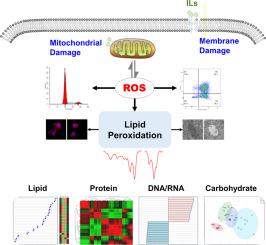Ecotoxicology and Environmental Safety ( IF 6.2 ) Pub Date : 2020-11-11 , DOI: 10.1016/j.ecoenv.2020.111629 Li-Xin Hu , Qian Xiong , Wen-Jun Shi , Guo-Yong Huang , You-Sheng Liu , Guang-Guo Ying

|
As an alternative to volatile organic solvents, ionic liquids (ILs) are known as “green solvents”, and widely used in industrial applications. However, due to their high solubility and stability, ILs have tendency to persist in the water environment, thus having potential negative impacts on the aquatic ecosystem. For assessing the environmental risks of ILs, a fundamental understanding of the toxic effects and mechanisms of ILs is needed. Here we evaluated the cytotoxicity of 1-methyl-3-decylimidazolium chloride ([C10mim]Cl) and elucidated the main toxic mechanism of [C10mim]Cl in human cervical carcinoma (Hela) cells. Microstructural analysis revealed that [C10mim]Cl exposure caused the cell membrane breakage, swollen and vacuolated mitochondria, and spherical cytoskeletal structure. Cytotoxicity assays found that [C10mim]Cl exposure increased ROS production, decreased mitochondrial membrane potential, induced cell apoptosis and cell cycle arrest. These results indicated that [C10mim]Cl could induce damage to cellular membrane structure, affect the integrity of cell ultrastructure, cause the oxidative damage and ultimately lead to the inhibition of cell proliferation. Moreover, alterations of biochemical information including the increased ratios of unsaturated fatty acid and carbonyl groups to lipid, and lipid to protein, and the decreased ratios of Amide I to Amide II, and α-helix to β-sheet were observed in [C10mim]Cl treated cells, suggesting that [C10mim]Cl could affect the structure of membrane lipid alkyl chain and cell membrane fluidity, promote the lipid peroxidation and alter the protein secondary structure. The findings from this work demonstrated that membrane structure is the key target, and membrane damage is involved in [C10mim]Cl induced cytotoxicity.
中文翻译:

基于咪唑鎓离子液体[C 10 mim] Cl对Hela细胞的负面影响的新见解:从膜损伤到生化改变
作为挥发性有机溶剂的替代品,离子液体(IL)被称为“绿色溶剂”,并广泛用于工业应用中。但是,由于其高溶解度和稳定性,IL倾向于在水环境中持续存在,因此对水生生态系统具有潜在的负面影响。为了评估IL的环境风险,需要对IL的毒性作用和机理有基本的了解。在这里我们评估了1-甲基-3-癸基咪唑氯化物([C 10 mim] Cl)的细胞毒性,并阐明了[C 10 mim] Cl在人宫颈癌(Hela)细胞中的主要毒性机制。显微组织分析表明,[C 10mim] Cl暴露引起细胞膜破裂,线粒体肿胀和空泡化,以及球形细胞骨架结构。细胞毒性试验发现,暴露于[C 10 mim] Cl会增加ROS的产生,降低线粒体膜电位,诱导细胞凋亡和细胞周期停滞。这些结果表明[C 10 mim] Cl可以诱导细胞膜结构破坏,影响细胞超微结构的完整性,引起氧化损伤,最终导致细胞增殖受到抑制。此外,在[C 10]中观察到了生化信息的变化,包括不饱和脂肪酸和羰基与脂质的比例增加,以及脂质与蛋白质的比例增加,酰胺I与酰胺II的比例降低,而α-螺旋与β-折叠的比例降低。mim] Cl处理的细胞,提示[C 10 mim] Cl可能影响膜脂质烷基链的结构和细胞膜流动性,促进脂质过氧化并改变蛋白质二级结构。这项工作的发现表明,膜结构是关键目标,[C 10 mim] Cl诱导的细胞毒性涉及膜损伤。











































 京公网安备 11010802027423号
京公网安备 11010802027423号